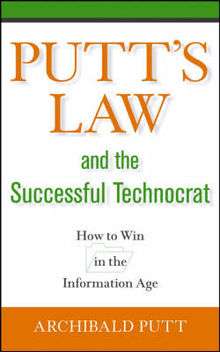Putt's Law and the Successful Technocrat
 | |
| Author | Archibald Putt (pseudonym) |
|---|---|
| Illustrator | Dennis Driscoll |
| Country | United States |
| Language | English |
| Genre | Industrial Management |
| Publisher | Wiley-IEEE Press |
Publication date | 28 April 2006 |
| Media type | Print (hardcover) |
| Pages | 171 pages |
| ISBN | 0-471-71422-4 |
| OCLC | 68710099 |
| 658.22 | |
| LC Class | HD31 .P855 2006 |
Putt's Law and the Successful Technocrat is a book, credited to the pseudonym Archibald Putt, published in 1981. An updated edition, subtitled How to Win in the Information Age, was published by Wiley-IEEE Press in 2006. The book is based upon a series of articles published in Research/Development Magazine in 1976 and 1977.
It proposes Putt's Law and Putt's Corollary[1] which are principles of negative selection similar to The Dilbert principle by Scott Adams proposed in the 1990s. Putt's law is sometimes grouped together with the Peter principle, Parkinson's Law and Stephen Potter's Gamesmanship series as "P-literature".[2]
Putt's Law
The book proposes Putt's Law and Putt's Corollary
- Putt's Law: "Technology is dominated by two types of people, those who understand what they do not manage and those who manage what they do not understand."[3]
- Putt's Corollary: "Every technical hierarchy, in time, develops a competence inversion." with incompetence being "flushed out of the lower levels" of a technocratic hierarchy, ensuring that technically competent people remain directly in charge of the actual technology while those without technical competence move into management.[3]
See also
References
- ↑ Archibald Putt. Putt's Law and the Successful Technocrat: How to Win in the Information Age, Wiley-IEEE Press (2006), ISBN 0-471-71422-4. Preface.
- ↑ John Walker (October 1981). "Review of Putt's Law and the Successful Technocrat". New Scientist: 52.
- 1 2 Archibald Putt. Putt's Law and the Successful Technocrat: How to Win in the Information Age, Wiley-IEEE Press (2006), ISBN 0-471-71422-4. page 7.
External links
- Archibald Putt: The Unknown Technocrat Returns (spectrum.ieee.org)
This article is issued from
Wikipedia.
The text is licensed under Creative Commons - Attribution - Sharealike.
Additional terms may apply for the media files.